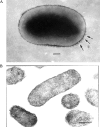Bartonella tamiae sp. nov., a newly recognized pathogen isolated from three human patients from Thailand
- PMID: 18077632
- PMCID: PMC2238074
- DOI: 10.1128/JCM.02120-07
Bartonella tamiae sp. nov., a newly recognized pathogen isolated from three human patients from Thailand
Abstract
Three strains of a novel Bartonella species (Bartonella tamiae) were isolated from human patients from Thailand. Sequence analysis of six chromosomal regions (16S rRNA, gltA, groEL, ftsZ, rpoB, and the intergenic spacer region) and phenotypical analysis supported the similarity of the three strains and placed them within the genus Bartonella separately from previously described species.
Figures


References
-
- Castle, K. T., M. Kosoy, K. Lerdthusnee, L. Phelan, Y. Bai, K. L. Gage, W. Leepitakrat, T. Monkakka, N. Khlaimanee, K. Chandranoi, J. W. Jones, and R. E. Coleman. 2004. Prevalence and diversity of Bartonella in rodents of northern Thailand: a comparison with Bartonella in rodents from southern China. Am. J. Trop. Med. Hyg. 70429-433. - PubMed
-
- Jeyaprakash, A., M. A. Hoy, and M. H. Allsopp. 2003. Bacterial diversity in worker adults of Apis mellifera capensis and Apis mellifera scutellata (Insecta: Hymenoptera) assessed using 16S rRNA sequences. J. Invertebr. Pathol. 8496-103. - PubMed
-
- Koehler, J. E. 1996. Bartonella infections. Adv. Pediatr. Infect. Dis. 111-27. - PubMed
Publication types
MeSH terms
Substances
Associated data
- Actions
- Actions
- Actions
- Actions
- Actions
- Actions
- Actions
- Actions
- Actions
- Actions
- Actions
- Actions
- Actions
- Actions
- Actions
- Actions
LinkOut - more resources
Full Text Sources
Molecular Biology Databases
Research Materials

